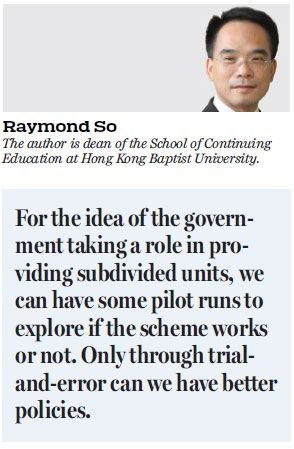Government-led subdivided units scheme worth a try
Updated: 2017-07-20 07:12
By Raymond So(HK Edition)
|
|||||||
The housing shortage is becoming a severe problem in Hong Kong. Property prices have risen to such high levels that many people find them unaffordable. The long queue for public rental housing has lengthened since the last administration and shows no sign of slowing down. Many low-income families now live in subdivided units which are small and not well maintained. Those subdivided units were often constructed with no proper regulatory approval hence there are always safety concerns. Many problems such as over-crowded living conditions, poor hygiene and fire hazards are often associated with these subdivided units. Worse still, rents of such undesirable housing units are often very high.

The new secretary for transport and housing mentioned that it was possible for the government to take the lead and provide subdivided units to those who are in the queue for public rental housing on a temporary basis. The idea is for the government to cooperate with non-government organizations in looking for old buildings which are slated for redevelopment soon. The NGOs could be assigned the task of renovating those idle buildings into subdivided units to provide temporary housing to people queuing for public rental housing. Of course, the conversion into subdivided units will be done on a legal way and conform to various safety regulations.
This idea has generated mixed public reaction. On the one hand, this new idea has won the support of many on the ground who said it would give society a much-needed solution to ease the severe housing shortage. Since the subdivided units are to be renovated from existing buildings with the needed infrastructure, conversion will be quick. Hence the subdivided units can be provided to the needy in a minimal time. Also, the buildings to be converted are already slated for redevelopment. The conversion, by definition, is only temporary as these buildings will be redeveloped soon. There will not be a problem of regularizing the subdivided units into formal public housing. Perhaps the biggest advantage of this idea is that those subdivided units will be regulated. Therefore they will not command high rental prices, and they will conform to all legal requirements.
However, notwithstanding the merits of this idea, some critics said it would not work. Much of the criticism lies in operational details. For example, though the conversion time is relatively short, the subdivided units are intended for temporary use only. In terms of costs and benefits, it will be uneconomical if the newly subdivided units are to be torn down and re-developed in a short period of time. If the subdivided units are to stay for a long time, there could be a lot of management concerns as the occupants may have lengthy tenancies, or there will be multiple rounds of move-ins and move-outs. Another concern is that the NGOs are supposed to be specialized in social services; they are not real-estate agents. Managing buildings and subdivided units will require a lot of knowledge and expertise in real estate. Whether the NGOs can handle those properties is a valid question. Moreover, people may perceive that the government has no effective way to solve the housing shortage problem and has to resort to providing subdivided units to residents.
I do not go to extremes but rather see the suggestion as a new idea worth studying and trying. My view is that we can never accomplish anything if we just sit on our hands and do nothing. We need to take risks and accept that not every trail will lead to fruits. This is the kind of mentality or attitude we should have when deliberating any creative or innovative idea or policy initiative. For the idea of the government taking a role in providing subdivided units, we can have some pilot runs to explore if the scheme works or not. Only through trial-and-error can we have better policies.
(HK Edition 07/20/2017 page8)